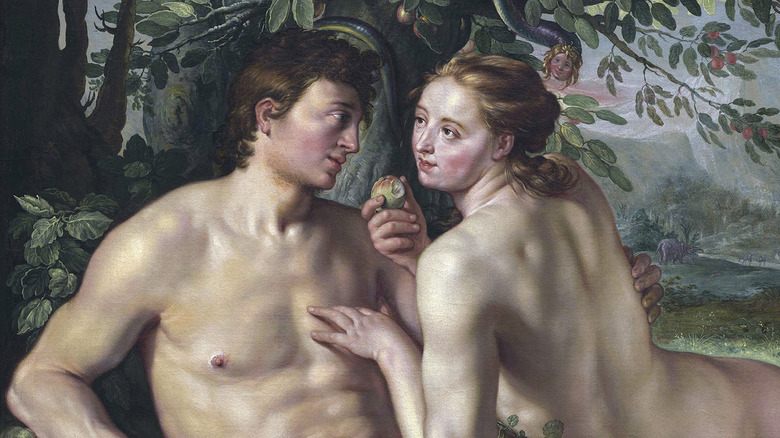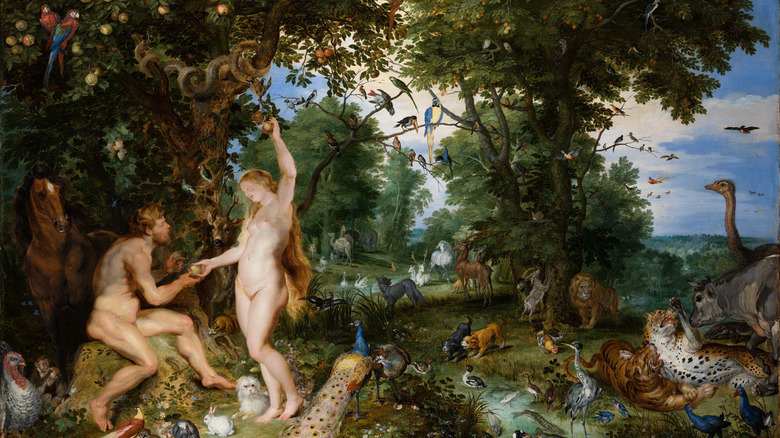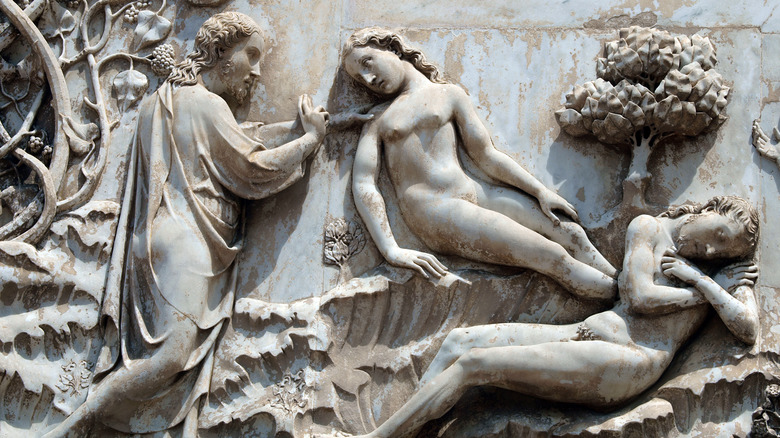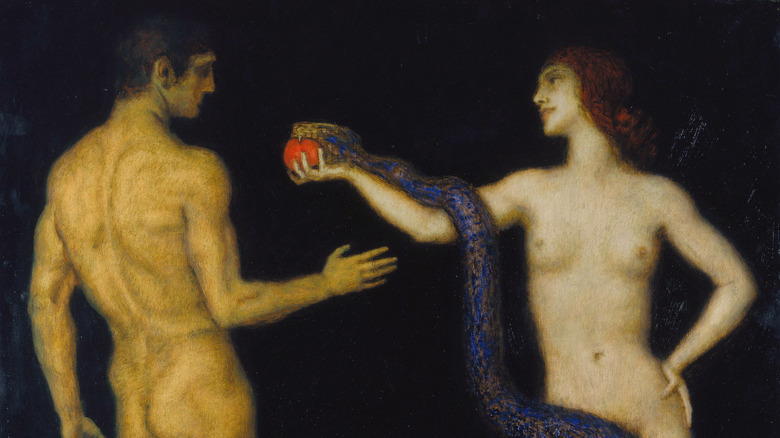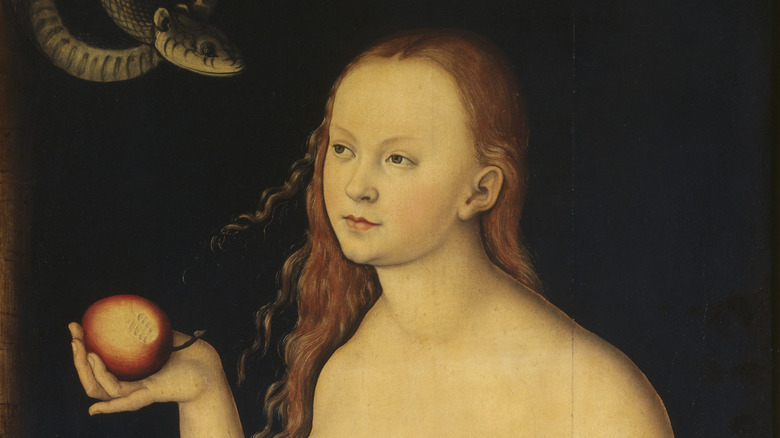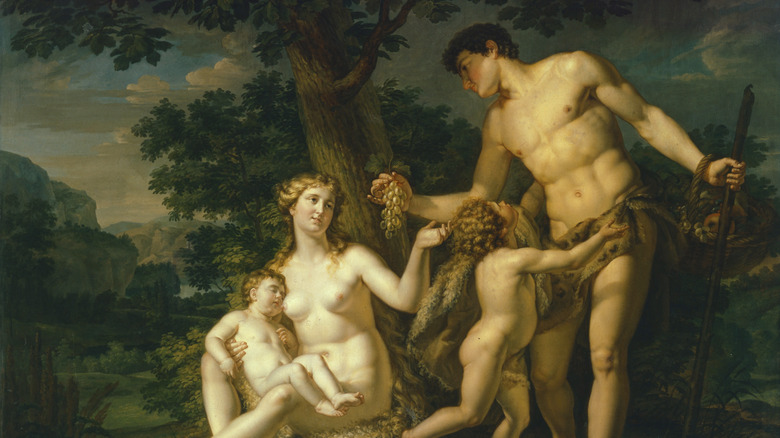Mysteries About Adam And Eve That Are Still Unsolved
The story of Adam and Eve is a cornerstone of religious texts found in Judaism, Christianity, and Islam. It appears in Genesis, the first book of the Bible, to explain the origin of human life on Earth. In the scriptures, Adam was created by God in His own image, as was Eve, who was crafted from one of Adam's ribs to provide the first man with a companion.
Genesis says that Adam and Eve lived a paradisiacal life in the Garden of Eden, a lush and verdant land of plenty where there is no illness or death and every necessity is provided for in the safety of God's love. But one day, Eve meets a serpent that convinces her to eat from the "tree of knowledge of good and evil." She shares the fruit with Adam, and the pair lose their innocence. God punishes them by banishing them from the Garden of Eden and sentencing them to the fate of having to suffer from sickness and death.
Whether you're a believer or not, chances are you are familiar with the story and its meaning. After all, the symbols through which it's told are foundational to a great deal of Western culture. However, despite being over 2,000 years old, there are several aspects of the Adam and Eve tale that still attract a great deal of debate among theologians and believers.
Where exactly was the Garden of Eden?
For many believers, Genesis appears to suggest that Eden was an actual place on Earth. If it was, though, its potential location is vague and still a matter of debate. It has been a topic of great interest for some of the biggest figures of Christian theology, including John Calvin, who analyzed the description of the garden in the Book of Genesis to try and narrow down its whereabouts.
What we do know from the scriptures is that the Garden of Eden was planted in the east, with the Bible naming four rivers that flow into the region from a single head, including the Euphrates and the Tigris (referred to in the scriptures as Hiddekel). However, though these streams both exist in the Middle East, there is no position on earth in which they meet as described in the story. One complication that Calvin goes into is the fact that the great deluge — the worldwide flooding that features in the story of Noah — would have overhauled the face of the planet. Indeed, it likely changed the land to such a degree that it no longer resembles how it did during Adam and Eve's spell in Eden. However, the Bible does not directly address this scenario.
Debate rages over the identity of Adam's 'rib'
The idea that Adam's wife, Eve, was created from one of Adam's ribs after God had put him to sleep is one of the most memorable images in the Bible's creation story. The tale is so well-known in the West that it is likely responsible for the myth that men have fewer ribs than women — both sexes typically have 12 pairs — a misapprehension held among both believers and non-believers.
Catholic theologists have claimed that Eve being made from Adam's rib, rather than the dust of the earth like Adam himself, is a symbolic mirroring of the Holy Trinity. According to this theory, Eve being made "of" Adam represents how the masculine God — the Father — is accompanied by the feminine Holy Spirit, which is also part of him. In Judaism, the selection of the rib — rooted linguistically to wisdom in Hebrew — is said to suggest modesty, in that it is found in a "concealed place within man."
But in recent years, the question of what exactly is meant by "rib" in the context of Genesis has caused a stir within theology. Professor Ziony Zevit of the American Jewish University has suggested that the Bible may in fact have been referring to the baculum, a bone found in the penis of most mammals, but absent in humans, rather than a rib. However, the controversial Adam and Eve theory has failed to become mainstream.
Were Adam and Eve tempted by Satan?
Among believers, Adam and Eve's downfall and banishment from the Garden of Eden is commonly said to be the root of humanity's separation from God and the origin of the difficulties that plague human life. Their loss of earthly paradise and the immediacy of God's love is precipitated by their fateful meeting with the serpent, who tricked Eve into eating from the tree of knowledge of good and evil. The incident is recounted succinctly and straightforwardly, with the cunning creature convincing Eve to eat the fruit with just two utterances. But why exactly did a being in the Garden of Even decide to deceive the first humans, leading to the fall of man?
The question has led many believers to an interpretation of the scene that is not actually described in the Book of Genesis at all: That the serpent was Satan in disguise, whose objective is the disempowerment of heaven and the debasement of human souls. However, such an interpretation only came long after Genesis was written, with Christian scholars retroactively identifying the serpent with Satan in light of the Book of Revelation describing the adversary as an "ancient serpent." The idea is also held by some in the Jewish faith, though the Book of Revelation is not in the Hebrew Bible. Jewish philosopher Philo, who lived around 2000 years ago, claimed that the serpent and Satan were not connected, and modern theologists don't believe the serpent was special in being able to speak — all animals in Eden could.
Was the forbidden fruit really an apple?
Two of the most miraculous objects to appear in the Book of Genesis are the tree of life and the tree of knowledge of good and evil. Even today, the symbolic nature of the latter plays into believers' understanding of human nature. All of humanity's woes, the story suggests, can be attributed to Adam and Eve's thoughtless bite of the forbidden apple.
But what evidence do we have that the fruit was actually an apple, as it is typically rendered in artworks depicting Adam and Eve? As of this writing, we have none. The Bible refers only to forbidden "fruit," going into no greater detail. In Hebrew, Genesis uses the generic word for fruit, "peri." Down the centuries, scholars have suggested various fruits as the fateful piece, including citron, grapes, and figs. However, the Latin translation of the Hebrew "peri" is "malum," which has historically been translated into English as "apple" — once a generic word for seed-bearing fleshy fruit. This is the likely origin of the apple in artwork depicting Adam and Eve.
What happened to Adam and Eve's other sons and daughters?
According to the Bible, all human beings share common ancestors in Adam and Eve, who were the first and only people on earth amid the fall of man. Having been banished from the Garden of Eden, they were said to have set forth into the harsh world, with cherubim armed with flaming swords preventing them from ever entering the garden again.
In exile, the guilt-ridden Adam and Eve were condemned to a life of work and toil, and had to conceive children through the painful process of birth. The Bible tells the story of their two sons, Cain and Abel (the latter is brutally murdered by his brother), and of a third son, Seth. All but Abel had children of their own, and the scripture briefly notes that Adam and Eve also had daughters. However, none of them are named in the mainstream Biblical canon, and details of their lives and whether they survived to have children of their own is missing from Genesis.
